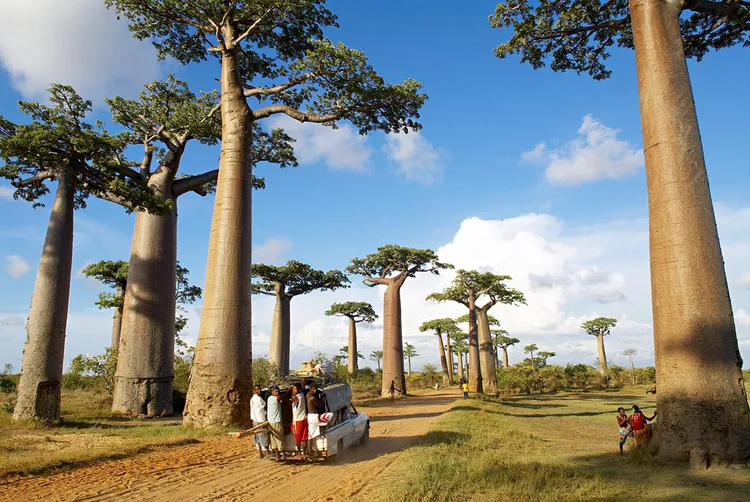1. Overview of Madagascar
2. Location
3. Geography
4. Capital City
5. Population
6. Language
7. Religion
8. Currency
9. Climate
10. Best Time to Visit
11. Key Attractions
12. Getting There
13. Medical Requirements
Meta Description: Explore Madagascar, known for its unique wildlife, stunning landscapes, and rich culture. Discover essential travel tips, key attractions, and best times to visit this enchanting island nation.
Madagascar is undoubtedly one of Africa’s most fascinating countries, and certainly one of the continent’s most unique. An island nation surrounded by the crystalline waters of the Indian Ocean, it’s most famous for its incredible flora and fauna – from its charismatic lemurs to its towering baobab trees. Much of the country’s wildlife is found nowhere else on Earth, and as such eco-tourism is one of Madagascar’s key attractions. It is also home to unspoiled beaches, breathtaking dive sites, and a colorful kaleidoscope of local Malagasy culture and cuisine.
Location:
The fourth-largest island on the planet, Madagascar is surrounded by the Indian Ocean and situated off the east coast of Africa. The country’s closest mainland neighbor is Mozambique, while other islands in the nearby vicinity include Réunion, the Comoros, and Mauritius.
Geography:
Madagascar spans a total area of 226,660 square miles/587,041 square kilometers. To put that into perspective, it’s just less than twice the size of Arizona and similar in size to France.
Capital City:
Antananarivo
Population:
In July 2017, the CIA World Factbook estimated Madagascar’s population at just over 25 million people.
Language:
French and Malagasy are the official languages of Madagascar, with various different dialects of Malagasy spoken throughout the island. French is generally spoken only by the educated classes.
Religion:
The majority of Madagascans practice either Christian or indigenous beliefs, while a small minority of the population (around 7%) are Muslim.
Currency:
The official currency of Madagascar is the Malagasy ariary. For up-to-date exchange rates, check out a helpful conversion site.
Climate:
Madagascar’s weather changes dramatically from region to region. The east coast is tropical, with hot temperatures and plenty of rain. The highlands of the central interior are cooler and less humid, while the south is the driest region of all. Generally speaking, Madagascar experiences a cool, dry season (May to October) and a hot, rainy season (November to April). The latter brings frequent cyclones.
Best Time to Visit:
The best time to visit Madagascar is during the May to October dry season, when temperatures are pleasant and precipitation is at its lowest. During the rainy season, cyclones can pose a threat to visitor safety.

Key Attractions
Parc National de L’Isalo
Parc National de L’Isalo offers more than 315 square miles/800 square kilometers of breathtaking arid scenery, complete with fantastic sandstone rock formations, canyons, and crystal clear pools perfect for swimming. It is one of Madagascar’s most rewarding destinations for hiking.
Nosy Be
The shores of this idyllic island are washed by clear turquoise waters, and the air is fragrant with the scent of exotic blooms. It’s home to many of Madagascar’s most exclusive hotels and is the destination of choice for wealthy beachgoers wishing to go snorkeling, sailing, and scuba-diving. Nosy Be is also one of the best places in Africa to swim with whale sharks.
Avenue of the Baobabs
In Western Madagascar, the dirt road that connects Morondava and Belon’i Tsiribihina is home to a rare botanical spectacle, comprised of dozens of giant baobab trees. Many of these magnificent roadside trees are several hundred years old and over 100 feet/30 meters high. Because the avenue isn’t part of a national park, visitors can view the trees for free.
Parc National d’Andasibe-Mantadia
Parc National d’Andasibe-Mantadia combines two separate parks, which together provide one of the best opportunities for a close encounter with Madagascar’s largest lemur species, the indri. A total of 13 lemur species live in the park, as well as over 100 bird species, many of them endemic (including the Madagascar yellowbrow and the Madagascar serpent eagle).
Antananarivo
Fondly referred to as “Tana”, Madagascar’s capital city is busy, chaotic, and well worth a few days’ visit at the beginning or end of your trip. It is a hub of Malagasy culture, known for its colonial architecture, vibrant art scene, and surprising number of high-quality gourmet restaurants. Top attractions include the Rova palace complex and Analakely Market.
Tsingy de Bemaraha National Park
Located in the remote northwest, Tsingy de Bemaraha National Park is famous for its astonishing karstic plateaus. These petrified forests are crafted from razor-sharp spires of limestone and can be explored via a series of suspension bridges. Keep an eye out for 11 species of lemur or endemic mammals such as the fossa and falanouc.
Getting There
Madagascar’s main airport is Ivato International Airport, located 10 miles/16 kilometers northwest of Antananarivo. The airport is home to Madagascar’s national airline, Air Madagascar. From the United States, most flights connect via Johannesburg’s O.R. Tambo Airport or Paris, France.
Non-nationals need a tourist visa to enter Madagascar; however, these can be purchased upon arrival at all international airports or harbors. It is also possible to organize a visa in advance at the Madagascan embassy or consulate in your home country. Check the government’s visa information page for more information.
Medical Requirements
There are no compulsory vaccinations for travelers to Madagascar; however, the Center for Disease Control and Prevention (CDC) recommends certain vaccines including hepatitis A, typhoid, and polio. Depending on the region you plan to visit, anti-malaria medication may be necessary, while visitors traveling from a yellow fever country will need to carry proof of vaccination with them.





